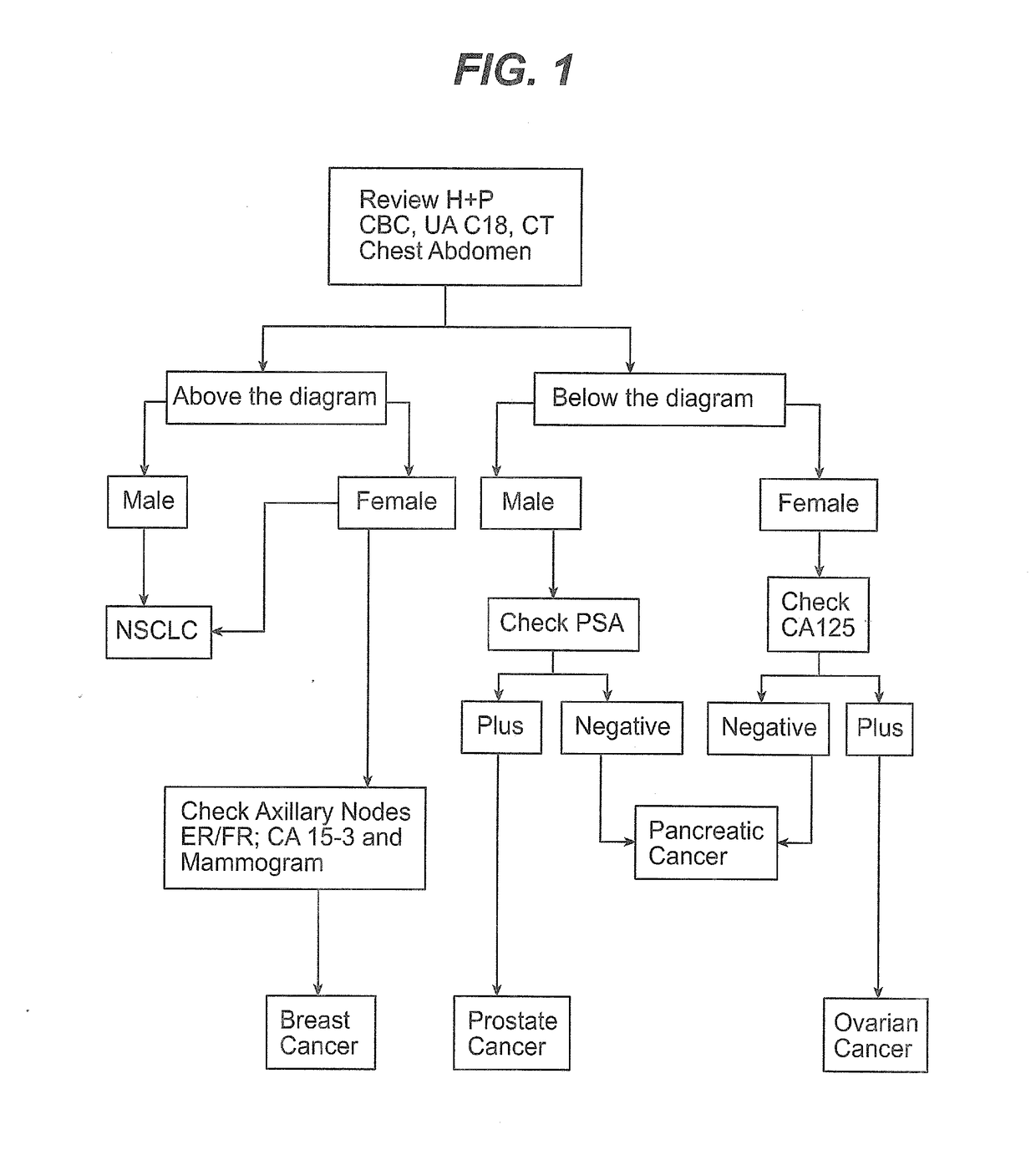Methods and materials for identifying the origin of a carcinoma of unknown primary origin
a primary origin, method and material technology, applied in the direction of microbiological testing/measurement, biochemistry apparatus and processes, etc., can solve the problems of more expensive diagnostic workups and the inability to perform reliably existing microarray protocols, so as to optimize the sensitivity and specificity of each biomarker
- Summary
- Abstract
- Description
- Claims
- Application Information
AI Technical Summary
Benefits of technology
Problems solved by technology
Method used
Image
Examples
example 1
Materials and Methods
Pancreatic Cancer Markers Gene Discovery.
[0092]RNA was isolated from pancreatic tumor, normal pancreatic, lung, colon, breast and ovarian tissues using Trizol. The RNA was then used to generate amplified, labeled RNA (Lipshutz et al. (1999)) which was then hybridized onto Affymetrix U133A arrays. The data were then analyzed in two ways.
Tissue Samples.
[0093]In the first method, this dataset was filtered to retain only those genes with at least two present calls across the entire dataset. This filtering left 14,547 genes. 2,736 genes were determined to be overexpressed in pancreatic cancer versus normal pancreas with a p value of less than 0.05. Forty five genes of the 2,736 were also overexpressed by at least two-fold compared to the maximum intensity found from lung and colon tissues. Finally, six probe sets were found which were overexpressed by at least two-fold compared to the maximum intensity found from lung, colon, breast, and ovarian tissues.
[0094]In the ...
example 2
CUP FFPE Total RNA Isolation Protocol
(Highpure kit Cat#3270289)
Purpose:
[0110]Isolation of total RNA from FFPE tissue
Procedure:
Preparation of Working Solutions
1. Proteinase K (PK) in kit
[0111]Dissolve lyophilizate in 4.5 ml Elution Buffer. Aliquot and store at −20° C., stable for 12 months.
PK-4×250 mg (cat #3115852)
[0112]Dissolve lyophilizate in 12.5 ml of Elution Buffer (1×TE Buffer (pH 7.4-7). Aliquot and store at −20° C.
2. Wash Buffer I
[0113]Add 60 ml absolute ethanol to Wash Buffer I, store at RT.
3. Wash Buffer II
[0114]Add 200 ml absolute ethanol to Wash Buffer II, store at RT.
4. DNase I
[0115]Dissolve lyophilizate in 400 μl Elution Buffer. Aliquot and store at −20° C., stable for 12 months.
Sectioning Paraffin Blocks ˜30-45 Minutes for 12 Blocks (12 Blocks×2 Tubes=24 Tubes)
[0116]Sections cut from the block should be processed immediately for RNA extraction
1. Use a clean sharp razor blade on Microtome to cut 6×10 micron thick sections from trimmed tissue blocks (size 3-4×5-10 mm).[...
example 3
Classification Tree
[0147]The classification tree is depicted in FIG. 8.
PUM
 Login to View More
Login to View More Abstract
Description
Claims
Application Information
 Login to View More
Login to View More - R&D
- Intellectual Property
- Life Sciences
- Materials
- Tech Scout
- Unparalleled Data Quality
- Higher Quality Content
- 60% Fewer Hallucinations
Browse by: Latest US Patents, China's latest patents, Technical Efficacy Thesaurus, Application Domain, Technology Topic, Popular Technical Reports.
© 2025 PatSnap. All rights reserved.Legal|Privacy policy|Modern Slavery Act Transparency Statement|Sitemap|About US| Contact US: help@patsnap.com



